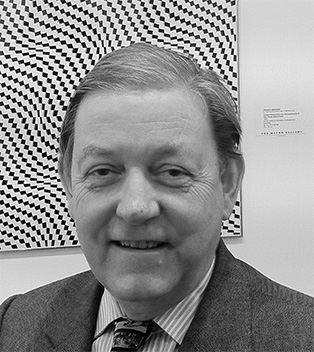
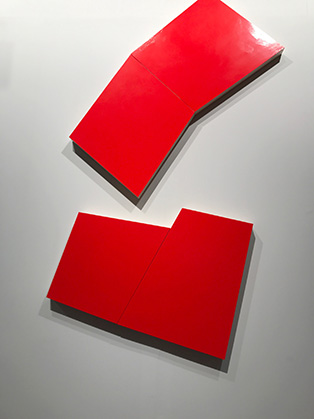
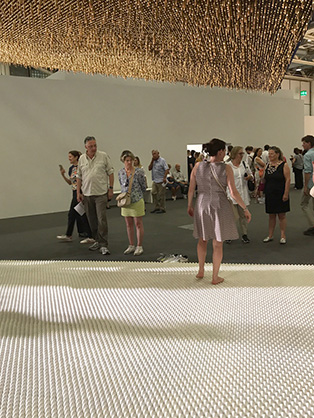
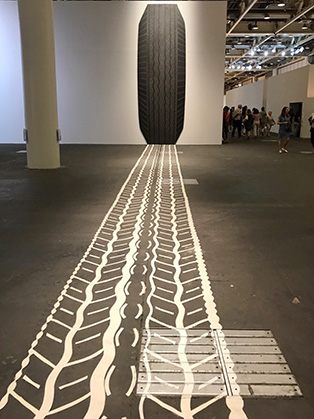
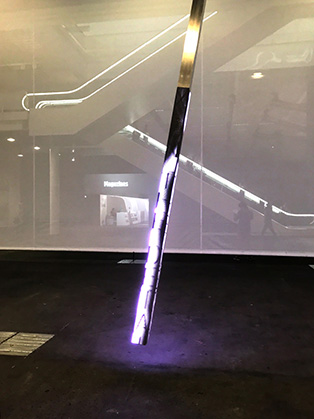
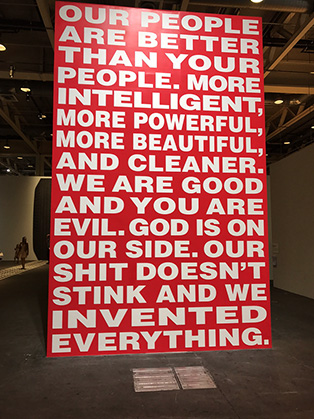
«ART-Gespräch mit James Mayor»
Von Julieta Schildknecht
Counter-culture remains seen as avant-garde by one of the best gallerists in Europe. His art knowledge grants him the possibility of taking decisions seen by many as risks. James Mayor indeed a legend in England’s art scene and mostly welcomed by respectful exhibitors who approach him to discuss possible deals way before art fairs open to collectors preview.
Who is James Mayor?
Who is James Mayor? Many people may wonder…
I have been told very many stories about this James Mayor from the past, the present and maybe from the future. Sometimes I have to correct them because they tell me a story about someone else and i have to tell them about myself and I have to correct them.
I started life or I suppose my career in 1968 working at the Louise Leiris gallery in Paris who was known for being Picasso’s dealer during Cubism and beyond. Then I went to New York in the Fall of 1968 and worked for Perls Galleries and my main job was painting and restoring Calder sculptures. In 1969 I came back to England and worked for Sotheby’s for a short time where there was not much for me to do so Peter Wilson who was Head of Sotheby’s at the time asked me what would you like to do? I said: “To go back to New York.”
So he posted me to New York and I was there for the next 3 and a bit years. I started the Contemporary Art Department which is now their biggest department. During the first sales in 1970 it was me working as a part time expert with a part time secretary. Now you see that between the auction houses they must be employing over 200 people.
At the end of 1972 my father was dying, I had to make a decision what I wanted to
do; whether to go back to England and take over the Gallery from my father or stay
in America and work for someone like Leo Castelli because my time with Sotheby’s was over. They were fed up with me and I was fed up with them. That was the basic start of my career. I came back to London and there was a slew of artists who weren’t showing in London like Rauschenberg, Twombly, Rosenquist, Lichtenstein, Warhol,
Oldenburg. Some of them had shown with Robert Fraser but Robert Fraser had left
the scene by then. There were other artists I was very intrigued by like Agnes Martin, Eva Hesse, Denis Oppenheim, Vito Acconci and Willian Wegman amongst
other artists. In many cases I was the first gallery to show them in London if not in
Europe.
That was my start. I was more interested in exposing the artists to a wider audience
than trying to sell to people interested in artists they already knew. In those days things didn’t fall of the wall. I gave something like 4 or 5 exhibitions to Twombly and only sold maybe half a dozen from all the shows. Basically as soon as the artist sort of “took off” I went looking for other pastures. I was mainly involved in the American market in the 70’s and 80’s.
There was also the revival of the Albers and Calder market. Calder I bought a lot with Leslie Waddington in the late 70’s and showed early 80’s. Albers I bought up a lot from Karsten Greve and showed in the late 80’s.
After the crash in the late 80s the price of American art had got unreasonable compared to other artists and it didn’t fit into my program. So I started looking! I started going more towards Europe and started a major clean on the French Nouveau Realism and from there I went to Zero and from Zero a little bit in South America and a little bit in Central Europe. There was always a fascination in the assemblage art of the West Coast and in the last 20 years I have been trying to be very involved with Bruce Conner, Mallary, Wally Hedrick among others. Basically I am more interested in awakening peoples awareness of important artists of the past rather than artists of today.
Are you a trend setter in the art field for the modern art?
I think that could be a bit too flattering. I think I wanted to make people aware, you
know I would look at an area or a school, or areas around a school that I initially I was drawn to and then work out which ones were potentially most interesting or mostly overlooked. A lot of them had been a la mode staged. Fashion changes, fashion comes in and out and I like to get in before the curve… When the curve or the wave starts to break, let other people get in there. My enjoyment in the business is buying and looking forward to curating and making shows with the spoils of my buying sprees. The selling is satisfactory when people start buying what was you proposed for them.
Can you define yourself as a mixture of a collector and a dealer?
Museums, collectors and a few dealers, I like to try and work with a hand full of
dealers each one on a separate agenda or on a separate purpose because that more
than doubles your exposure.
Yes, are you collecting as well if you are buying without thinking of selling?
Well I only buy what I like. The only disasters in my financial life have been buying something because it was cheap. There is no such thing as a free lunch.
So you have an eye for what is coming as a trend?
I don’t know. I hope I do. I think people who I know are people who have been
around for some time rather than people who are just trying to be hip. They know I
do know what I am doing. I think they respect it and follow my judgement and I
hope they enjoy what they bought. I think mostly they’ve made finally a good
financial decision. It is more important that someone loves what they bought than
someone who is looking for an investment. There are still people thinking art is a
good investment. I don’t think so as all you hear about are the winning bets, and
never about the bucket full of losing ones.
What makes you choose before buying?
I do a lot of thinking. What instinctively I am attracted to… I don’t like pretty art
really… I think art should be a challenge, a mental challenge. I think the problem
with too much contemporary art is it’s just pretty. It might be using strange materials but basically it’s just pretty. I think when I was young, a teenager I liked different art than what i like now. But when I was at school my sanity was led by the art master and I painted Pollocks, I painted Rauschenbergs, painted Miros, painted a lot of things… which I suppose for a 16 year old in 1965 was quite brave.
This means you know about painting?
Yes, painting! My grandfather had been a painter. My father once said he wanted to
be a painter and Arthur Rackham, the illustrator, lived in the next-door village to
them… When my grandfather died, my father was 13. When my father left school
and was thinking of going to art school, he bicycled over with his portfolio of water colours to show Arthur Rackham. “These are bloody awful imitations from your father and he was bad enough” was Arthur Rackhams comment so my father got the hint.
Did you go to an art school?
No, no I didn’t.
Was it a hobby for you?
Yes, and I really enjoyed it and it was sanity for me. I think it actually helps a lot in
looking at art to actually get your hands dirty.
Besides curating are you also helping to mount your exhibitions in your fairs?
The acreage here is very carefully thought out. We spend a long time designing the
stand and then trying to bring the art pieces into rooms. I think it is important to
have people realise they could live in this set. this is sort of a room set-out to live in.
Are you a curator?
I say I enjoy buying and displaying, I think how you display the work is incredibly
important and framing and this and that. People don’t understand that you really
need it.
Are you a dreamer?
I think I am dreamer not a fantasist. I think you are allowed to dream if you are not
willing to be a fantasist.
And how do you dream when you are curating the work you are curating in your
gallery?
I just want to make it a peaceful and happy venue. Here for instance is the Latin American section. Then this is all the black and white. (James Mayor stands and
walks up to another part of his stand to explain further). This is old 60’s and central European… (With his right arm lifted pointing to the right side while walking) American… This is very peaceful with mainly European artists the same sensibilities…. All carefully configured to show as much of our program as possible. Let’s put it like this: if you go to an art fair, you have two choices: one is to do a one man show, or take in a movement and make it as simple and as informative as possible. The other way, which we do mostly for Basel and Maastricht is to give an overview of the art that we are dealing in.
Is it a risk to work like that or which would be the best for you?
Well, basically we own 80% of what we show, you are always gambling but the
difference between a professional gambler and an addicted gambler is: the
professional gambler only bets when he thinks the odds are in his way. When we choose an artist we really believe we can do something for them.
How are you investing on artists on the long term?
Yes, on the long term… some of these I have a handful of them, some of them I
have 40 or 50 of their works.
Are you close to them sharing their lives?
Well some of them are dead, so I hope I am not sharing their lives…
I mean in general!
Well, you know there are some artists I’ve shown that as human beings I find
extremely unattractive and I can’t be objective about their work. I’ve personally
owned some work by these artists and I have had to sell them as they reminded me
too much of the artist.
Were you dealing with them?
Yes…
On the private side and then you became acquainted with their work?
No, I knew their work, I got involved with them and I decided that was enough. After that I didn’t want to deal with their art at all.
There is a picture of you with Andy Warhol…
Yes!
When did you meet him and how did he influenced your work?
I met him in about 1970 when I was living in New York. I knew him in his last 16
years of life. I had a Kuwaiti girlfriend who was on their Arts Council board. She
said: “You know you bring an artist, do a show and become an official guest here.”
So I asked: “Do you want me to bring Warhol?” And she said: “Warhol?
Absolutely fine.” So we went there as guests and we were having lunch with this
Sheikh and he said to me: “You brought me Andy and i will bring you Salvador.” It was fun.
Did he bring Salvador?
No, he didn’t.
Did Andy Warhol influenced your work as well personally speaking?
No, but I knew him well and I had great respect for him. I think later, the much later
work, when he moved from the Union Square to the Conrad Building on Madison
Avenue he did became really quite commercial. I think there is really good later work but there is absolutely horrendous commercial crap.
What do you have from Andy Warhol in your…
At Home?
Yes or in your Gallery?
I don’t have very much in stock. I’ve got 3 at Home: I have one of his “Torsos”
that he gave me as a wedding present, I have an early 60’s silkscreen and a shoe
drawing, and we have a work in the gallery’s stock which always seems to be in
museum shows.
Regarding the american artists that you brought to Europe, which one was your
favourite as a person?
Basically between Oldenburg and Rosenquist. Both complete geniuses, both
misunderstood. Oldenburg is one of the great draftsman of all time and definitely
one of the great sculptors of the last 40 years.
In which art period are you concentrating now? Did you decide to keep those
artists as well?
At the moment there is a handful of artists I am interested in from the West Coast
and I buy what i can buy. There is Mallary, Hedrick and Conner and there are one
or two others that i think are really really interesting. I think they are still misunderstood and there are some very important positions people haven’t yet seen. There is some very interesting artists from Central Europe I am trying to get familiar with.
Contemporary?
No, from the 60’s and the 70’s. There are one or two very interesting artists from
Spain, there were very popular when Spain came out of the dark ages but sort of
gone off the international radar. Some of the Spanish artists who are enormously
underrated.
How long have you been doing Art Basel, how many years?
I first did it in 1973, i applied in March or something and was given a stand in June. I did it 73, 74, 75 and 76. Then I didn’t do it again until the early 90’s when I did it about three years and then I have been exhibiting since the last 10 years or so. I had about three interventions.
How about Maastricht?
I have been doing Maastricht for about 25 years.
Are you looking into doing other fairs?
I have done various other fairs which I am not be doing it again and we’ve done
Frieze Masters the last three years. The first year we did Fangor a polish artist, very
interesting and resurrected, he was internationalised. Ad Dekkers who died very young, a Dutch artist of late 60’s early 70’s and in New York we did Robert Mallary and these were paintings from 57 and 58. This year is the 100th anniversary of De Stijl and we will be doing a group of new De Stijl who called themselves structuralists in Frieze Masters in London in October.
When you don’t own the artists works you are exhibiting, are the works coming
through the artists estates?
Yes, you have to plot it.
You mean you are working with inventories?
Yes.
Is this part of your experience at Sotheby’s?
No, because you have to realise the auction houses have only one aim and that’s to
sell it. The difference of selling from not selling is making money or not making money. They don’t need it, it doesn’t matter if it goes for a lot of money because that’s publicity for them. Just to get it sold that’s all they care about. By hook or by crook they’ll sell it.
In this case would you say that you want to take into a different direction and
implement art your own way?
Well, I think when everybody is selling and buying what you are selling and
buying is boring. One is constantly looking for new avenues to go after.
But you are the one setting trends?
Yes, but it’s our decision which avenue we go then. People make ideas to us the whole time but we analyse it and make the decision if we want to pursue it or not. Now, there is no point in pursuing an artist if there is somebody else holding a large amount of the work because there you will never be in control. You either buy them out or you drop that artist.
You do this dealing through connections, right?
Yes.
And a good nose?
It’s all nose. (smiles)
I once heard a story of how Rothko’s work was held in an airplane on an airport in
America right after his death in order to keep his gallerists interests safe from others. Did you go through situations that were similar to this one?
Not like that because Rothko was a high sale name at that stage.
But with Lichtenstein or Rauschenberg?
Well, I knew them all since 1970. What people don’t realise is that the art world wasn’t a booming business in those days. There were only a handful of collectors.
And how about the key galleries?
The galleries were far more important than they are now. The collectors were much
more committed, it wasn’t about the money.
Would you say that the traditional galleries are like a place for reunion of artists?
Well, the problem is that up to 1990 all the big galleries were employing less than
10 people, except for the Marlborough gallery which was the forerunner of the new
mega gallery.
In one of your documented interviews there are some old pictures showing an
opening with a lot of performance. What do you think of that time when
performances took place during big openings?
Well, it was still when the openings were interesting, you went because you didn’t
know what you were going to see. Now you know what you are going to see and it’s a different form of party time.
Your party time is different than most of the galleries in London? Do you have
openings at hours when people are not used to?
No, I don’t think so.
Are you opening in the evening?
In London everybody opens in the evening.
Or in the afternoon?
Not really, I always opened in the evening.
Are you also organising talks?
No.
Why not?
Ones fear is that nobody turns up, rather embarrassing. Paul McCartney always said to me, his biggest nightmare was that he going on stage to sing “Yesterday” and nobody is in the room.
But you have very good artists that could give talks, right?
Yes, what we try is either to get studio international to interview them or get Hans
Ulrich Obrist to interview them… which I think is a) being interviewed by smart
people who know what the subject is and b) this information will be there for a
long time. I think this is more interesting for people to read it or hear it than having
people asking yes or no questions.
You are a big researcher right?
Well yes and no. I use instinct mainly.
What do you do with such a beautiful library you have in your gallery?
Well I like researching, looking things up. I want to check something. I just want to
try “was I right” and “was that there”. It is really just a way of waking up to things.
So you like books?
Yes, I don’t like electronic gadgets. I love going to bookshops, I like old bookshops
like old ironmongers.
You are editing more than catalogues which look almost like books from your
exhibitions, right?
Well, I think in the end people will claim they went to an exhibition they never did.
But if there is a catalogue there is a record. I think catalogues of exhibitions will be
a lot more interesting than things online but that is besides the point. I just love the
feel of it, I think books are a beautiful thing.
A common material between books and many of the works you are selling is paper.
Yes.
What is it, does it make a difference when you are looking at them?
I actually collect myself more paper than oil. I believe that you can own a drawing
but you can never own a painting.
Why?
I think a painting is almost a public property but a drawing you can hold (put in
your hands) and it’s just you and it communing. It’s much harder to commune with
a painting like that if you see what I mean. I can understand why people have great
libraries and great collections of drawings, engravings and such. It’s only you and
it and you are having a great very personal private conversation. It’s quite hard to
have a private conversation with a painting.
So how far are you personal with all the work you are selling?
Well, if I didn’t like it I would not have it up.
Are you interfering on the way the work is being framed?
The problem with framing is there is a time when frame represents a time. There
was the frame done in the 50’s going through that. Sometimes it is successful
sometimes it isn’t and it’s redone, people say oh gosh I don’t like that.
They look like treasures the frames…
Well, the thing about frames is that it should be anonymous. It should make the
painting or the drawing breathe and not make a statement itself. Some people like
these very baroque or whatever… ok, it does work in certain paintings but it
doesn’t on others. I think that with almost all frames “less is more”.
How many sculptures do you have here today?
Only three I think, three standing sculptures.
From the 50’s?
That’s new, that’s 60’s those are about the 60’s I think.
And the material, does it make a difference for you?
Well, I think the material of a sculpture should be sexy, right? I think that piece is
incredibly tactile.
Sexy you mean tactile?
No, I mean sexy and tactile.
Are you considering that art has a sensuality because of its shape?
Yes, I think art has a soul, i think art is sometimes sexy. I think different people have different views of sex.
But then its erotic or is it sensual?
No, I think sexy, sensual and erotic are all different. I think erotic is cheap thrills.
Are you selling sexy work?
Well, I find quite a lot of this is quite sexy. Calzolaris work is very sexy.
So you see that as a tactile feeling?
Yes, there are good and there are bad things.
Depending of the school, In many of your works there is a lot of texture and three
dimensionality, right?
I think texture is exciting. Sometimes it gets quite dull when they don’t have one.
You should be made to stop and look for the right reasons.
From my short experience in England or in London, better said, your work choice
is very special
Yes, but I think I have a catholic taste, I believe in live and let live, I am not
judgmental to people, I don’t care what people do with their genitalia that’s their
problem and I think life is a very interesting thing and I am immensely curious. If you don’t have curiosity you might as well shoot yourself and do everybody a
favour.
Being a gentleman when making your choices just like you said, you don’t want to
look cheap, right?
Well. I think you have to respect what you are looking at, you have to respect what
it is.
How are you dealing with imagination? Is it connected to the visual impact the
viewer has?
I think imagination is part of curiosity. I think it’s terribly important. Never accept
what you are told to accept without looking at it properly.
And the time for that, how much time do you need to watch?
I think the first impression is almost always correct.
For anybody?
Yes, but they don’t know how to use that first impression.
We are on a time, or coming into an age if we can say that, where people don’t give
much time to look, to observe…
Yes, and I think it’s terribly sad. I think that the internet is terribly dangerous because it gives a lot of information but no knowledge. Quite often you go to Museums and these people are listening (to those earphones) but then they are listening to a one persons point of view…People are not having personal conversations, they are having one sided lectures. No Q & A afterwards, and they are all going out spitting the same thing which is very dull.
What is that in terms of marginalising the meaning of art?
I don’t know. Definitely some people have a whole awakening and then other
people do go along on a general ride, party time and all the rest which is of not
much use.
How much longer are you going to be a gallerist?
As long as I have projects.
Do you have many projects?
Tons of them.
Yes?
Yes, I’ve got tons of note books for a broadcast…
Have you seen Woody Allen how much does he has, he is writing, writing non-stop
writing?
Yes, like when a tree is dying it sends more seeds from the self. Maybe Woody
Allen is thinking of his last laps and you have to get as much done as possible.
You said to give a lot of thinking…
Yes.
Are you thinking to yourself or of other people when you are exhibiting here as a
gallerist?
This is sort of the eggs being laid now is party time. This is the start of the action
process.
This being a non-stop work?
Yes.
And regarding the many projects, can you share some of your projects?
Yes, I do. I quite often do it with other people because the exposure in a gallery in
London is quite minimal.
Is that the reason why you are traveling so much?
Yes.
Are you doing collaboration with other galleries?
Yes, absolutely.
Which ones?
Various.
No names?
No, no.
Is it more backstage?
Yes.
Is it interesting commercially speaking?
Sometimes, they are anonymous or briefly anonymous. You might need to read our
catalogues to find out.
Do you want to pass your business to others?
I don’t know, I really don’t know. It’s changed so dramatically.
Your team is good, right?
Yes, I am very happy with them.
You have two or three people working for you?
Yes, full time.
For many years, right?
Yes.
Is it like your family?
Yes, I am happier with my family but I am very happy with my secretary. Blood is
thicker than water.
Blood is thicker than water. What does that mean?
Your family comes first.
Do you have someone in your family who is going to take over the gallery?
I don’t know.
Any message you would like to give to the people reading your interview?
Buy from your heart, not from your wallet.
Difficult for Swiss people…
You know, don’t worry about it. If you worry about what it is going to be worth in
two years time, you made a mistake.
Can you advise them?
People ought to look, see what they like and buy what they can afford to buy.
But if they decide to contact you, would you advise them?
I would try and work out what and where their initial taste crosses. And then work
from there. If the person has nothing in common with you at all, there is no way it
can work.
Are you working with trusts?
I work with a number of them and I made a lot of collections for people. But then
there are people I couldn’t work with because their aims and tastes are alien to
mine. If you can’t have a mutual stomping ground there is absolutely no point at all
in doing anything.
Are you specialised in 50’s, 60’s and 70’s art?
Yes, I have dealt a lot in surrealism but it is too expensive for me to hold in stock
and there is not enough around. I prefer to deal in things where there is enough
work to deal with. Any further information, if required, is available in our website https://www.mayorgallery.com

